TANUVAS has developed several innovative technologies and some of the technologies that were commercialised are as follows.
| Technologies Commercialised | Company / Agency to which the technology has been transferred |
|---|---|
| Multivalent Bluetongue Inactivated vaccine | M/s. Brilliant Bio-Pharma Ltd., Hyderabad |
| Products on Bovine TB alert kit, ABT choice kit and EndoMetB | M/s. Genomix Healthcare India Pvt. Ltd., Hyderabad |
| Rapid plate agglutination for Mycoplasma gallispeticum | M/s. Venkateshwara Hatcheries Ltd., Pune |
| TANUVAS live attenuated Goat pox vaccine | Bio-Pharma Ltd., Hyderabad |
| Nano NDV for oral delivery and platelet therapy for mastitis | M/s. Hester Pharma Ltd., Ahmedabad |
| Scientists involved | Dr.V. Balakrishnan |
Product Technology 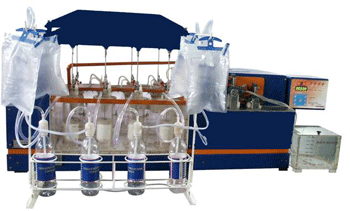 |
An alternative to animal experiments in animal nutrition research have developed indigenously. The technique is called as RUSITEC (Rumen simulation technique) that can replace cattle used in experiments. Since it was developed at Tamil Nadu Veterinary and Animal Sciences University, it is named as TANUVAS – RUSITEC. |
| Product Presentation | TANUVAS – RUSITEC consist of
Water bath Reaction vessel Perforated cage Effluent bottle Gas bag Saliva tank Peristaltic pump Water heater Control panel. |
| Product Utility |
TANUVAS - RUSITEC is basically an in vitro semi continuous culture system. It simulates heterogeneous rumen under simplified conditions. The apparatus is designed to run continuously and gives the operator maximum control. The inputs as well as the outputs including the gases can be determined using it. Accurately weighed 10 g of feed / fodder to be tested for their nutritive value is placed in the perforated cage along with the inoculum (microbes) from the donor animal (input) in the reaction vessel. The researcher regulates the flow rate of saliva according to the physiological status of the cattle. The amount of solid material that leaves the vessels each day is known as it is taken out manually. The output or the end product of fermentation (VFA, methane and CO2) can be determined from the effluent. The complete unit has eight reaction vessels, each representing a cow. Thus TANUVAS – RUSITEC is sufficient enough to conduct a valid number of replication to derive meaningful conclusion in research work. High end research for indepth study on intricate aspect of nutrients can be studied through this instrument. TANUVAS – RUSITEC has the following advanced features: The water bath temperature is controlled effectively through electronic device with allowance to fluctuate only ± 0.5C Provision to circulate the water in the water bath through heating coil with a automatic cut off, in the event of low level of water. This provision is very handy to prevent electrical short circuit. Beep indicator alerts the declining level of water. Peristaltic pump capable of delivering 8 outputs simultaneously through electronically controlled device to facilitate 8 different saliva flow rate. Thus feed/ fodder could be simultaneously evaluated for 8 different physiological statuses with same culture. Toggle fasteners to secure reaction vessel facilitate easy operation by girls independently. Compact and occupies less desk space TANUVAS - RUSITEC would cater the needs of research laboratories involved in conducting nutritional research in ruminants, Pharmaceutical companies engaged in research and development, Analytical laboratories attached to feed industry. |
| For further details contact |
Professor and Head, Department of Animal Nutrition , Madras Veterinary College, Chennai 600 007 |
| Name of the Product |
Monoclonal antibody based progesterone assay for early pregnancy diagnosis in cattle |
| Scientists developed |
Dr. V. Thiagarajan Dr. V.D. Padmanaban |
Product technology 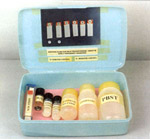 |
Development of monoclonal antibody to reproductive hormone progesterone and estimation of the hormone in the milk using the Mabs in Dipstick ELISA and Latex Agglutination Test to detect the pregnancy / non pregnancy status of cows. |
Product presentation  |
Dipstick ELISA Progesterone monoclonal antibody Progesterone labeled HRPO Nitrocellulose membrane LAT Latex beads coated with progesteroneMabs |
| Product Utility |
Progesterone assay is to be done on milk samples collected from lactating cows from 21 to 24 days post breeding.The pregnancy/non pregnancy status of the animal will be identified around 24 days after breeding. The accuracy of the test is 100% in detecting non-pregnancy and 80-90% pregnant cows. |
| For further details contact |
Dept. of Animal Biotechnology, Madras Veterinary College, Chennai - 600 007., TANUVAS |
| Scientists involved |
Dr.B.P.Brahmkshri Dr.Thilak Pon Jawahar Dr.M.John Edwin Dr.K.S.Raman |
Product Technology 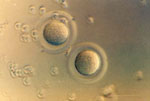 |
Hamster oocyte is unique in that, its zona free state can be penetrated by spermatozoa of several species depending up on the fertility potential of the sperm tested. The golden hamsters are superovulated, oocytes collected, cryopreserved at –196°C for long time storage. This forms ready availability of oocytes for sperm penetration bioassay. |
Product Presentation 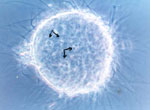 |
Twenty oocytes are packed in French mini straws, stored at –196°C in LN2 and supplied. |
| Product Utility |
Sperms of different species can be tested viz., Human,Bull, Buffalo, goat, sheep, pig, horse and poultry. Useful in periodic monitoring of fertility status of bulls used in Semen Bank for AI program. Human IVF laboratory can employ this test for screening the donors in Assisted Reproductive Technology. This test can form a part of quality control test in semen production laboratories. |
| For further details contact |
Semen Bank Department of Animal Genetics and Breeding Madras Veterinary College Chennai – 600 007 |
| Scientists involved |
Dr.A.Koteeswaran Dr.T.G.Prabakar Dr.T.V.Meenambigai |
| Product Technology |
Diagnostic kit for detection of Bluetongue antigen and antibody |
| Product Presentation |
The kit consisting of Lyophilized Bluetongue antigen and Bluetongue antibody (1ml each) Agarose – 1g Phosphate buffered saline (2ml) |
| Product Utility |
Bluetongue (BT) is a disease of economic importance of sheep and goats. BT caused large scale mortality in southern districts of Tamil Nadu during 1998. The disease should be diagnosed at the earliest for effecting control measures. Hence a diagnostic kit for detection of BTV antibody was developed at TANUVAS. Tests for BTV antibody can be done at field level laboratories using this kit. Purified BTV antigen can also be detected using this kit. |
| For further details contact |
Vaccine Research Centre Viral Vaccines, Centre for Animal Health Studies, MMC, Chennai – 51. |
| Scientists involved |
Dr.V.Ramasamy Dr.M.Joseph Andrew Jesudass Dr.J.John Kirupakaran Dr.G.Ravikumar Dr.N.Latha |
| Product Technology |
Clostridium chauvoei strain No. 49 has been used for vaccine production.It was improved for its core antigens and an alum precipitated Black Quarter whole culture vaccine was prepared as per FAO norms. |
| Product Presentation |
Alum precipitated Black Quarter (Clostridium chauvoei) vaccine in 30ml, 50ml and 100ml bottles. |
| Product Utility |
Used for vaccinating cattle, sheep and goats against Black quarter. Dose : Cattle - 2ml s/c Sheep and goats - 1ml s/c |
| For further details contact |
Centre of Animal Health Studies, Madhavaram Milk Colony, Chennai - 600 051. |
| Scientists involved |
Dr.K.V.K.Veereswaran Dr.C.Nareshkumar |
| Product Technology | 30% replacement of milk fat (cream) with rice branoi 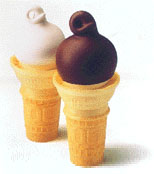
|
| Product Presentation |
50 / 100 ml. Cups reduction in cost |
| Product Utility |
For diet conscious people as rice bran oil has hypocholestraemic effect. |
| For further details contact |
Department of Dairy Science, Madras Veterinary College, Chennai - 600 007. |
| Scientists involved |
Dr.B.Dhanalakshmi Dr.C.Nareshkumar |
Product Technology  |
Freeze-drying. |
| Product Presentation |
Capsules stored at refrigeration temperature. |
| Product Utility |
Preparation of fermented milk product. It is a probiotic culture. |
| For further details contact |
Professor and Head, Department of Dairy Science, Madras Veterinary College, Chennai - 600 007. |
| Scientists involved |
Dr.B.Chandrasekar Dr.K.T.Radhakrishnan |
Product Technology 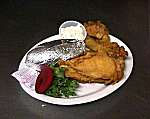 |
Spent broilers were utilised for the preparation of cured and smoked chicken. Curing mixture consisting of purified salt, cane sugar and sodium nitrate were applied by rubbing thoroughly over the dressed chicken carcass. The cured carcass was stored in a domestic refrigerator for 24 hours for curing. Subsequent to curing the cured carcass was desalinated in warm water for 1 hour. The carcass was smoked for 12 hours at 55° to 60° C. Later the product was allowed to age at refrigerator temperature for 24 hours. |
| Product Presentation |
The cured and smoked chicken is carved into different joints. These joints are further sliced and served after frying. |
| Product Utility |
The marketing of culled birds has been causing a problem in the economic maintenance of large commercial poultry farmers. To over come this problem poultry meat can be cured and smoked to extend its shelf life. This process also facilities easy handling and transportation from production centre to areas of consumption. Such product helps the farmer to enhance the value of the culled chicken. |
| For further details contact |
Department of Meat Science and Technology, Madras Veterinary College, Chennai – 600 007 |
| Scientists involved |
Dr.K.T.Radhakrishnan Dr.V.Venkataramanujam |
Product Technology  |
Chicken meat and fat from culled birds were utilised for the preparation of sausages. Meat was minced separately in a meat mincer and fat was added at the time of emulsion preparation. Dry cure method was adopted with salt, sugar, potassium nitrate, Ascorbic acid and Onion with rusk. The emulsion was prepared and stored for 24 hours at refrigerator temperature. The emulsion was stuffed into wet sheep casings. The stuffed product was smoked at a temperature of 45° to 50° C for 2 hours. The smoked product was cooled and aged at refrigerator temperature for 24 hours. Then the product was cooked at 80° C for 2 hours in a hot air oven. The cooked product was cooled and stored at 8° to 10° C. |
| Product Presentation |
The chicken sausage can be presented as hot dogs, sandwiches, salads and also consumed after frying. |
| Product Utility |
The advent of broiler industry has rendered the marketing of culled birds difficult in view of the toughness of their meat. Such chicken meat can be conveniently converted into value added poultry meat product such as chicken sausages and marketed. The present consumer demand for processed meat foods can be fulfilled by popularisation of this product |
| For further details contact |
Department of Meat Science and Technology, Madras Veterinary College, Chennai - 600 007. |
| Scientists involved |
Dr.K.K.Aravindan Dr.G.Thulasi |
Product Technology 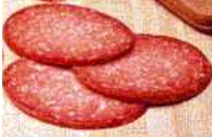 |
Chicken meat obtained from culled birds was minced in a meat Mincer and the curing mixture (comprising of salt, sugar, Potassium nitrate and Ascorbic acid) was applied thoroughly by hand rubbing. The chicken meat was cured for 24 hours in a domestic refrigerator. The cured meat was chopped with slushed ice, extending material (defatted soy flour), preminced condiments (pepper, coriander, mace and cinnamon), flavouring agents (garlic, onion and ginger). The emulsion was then moulded into round shaped patties. The prepared patties was cooked by dry heat in a baking oven to reach an internal temperature of 72° C. The cooked patties was stored in a freezer at -18°± 2° C. |
| Product Presentation |
The chicken patties can be presented as sandwiches, Salads and also consumed after frying. |
| Product Utility |
Processed meat products are becoming popular now-a-days due to the changes in socio-economical status of the consumers. Patty is one of the comminuted value added and convenience meat products. By popularizing this product, the present consumers' demand for processed meat foods can be fulfilled. |
| For further details contact |
Department of Meat Science and Technology, Madras Veterinary College, Chennai - 600 007. |
| Scientists involved |
Dr.K.S.Palaniswami Dr.A.Thangavelu Dr.A.Koteeswaran Dr. K. Saravanabava Dr.K.Nachimuthu |
| Product Technology |
Live PPR virus adapted and attenuated in vero cells by serial passage for 75 times. |
| Product Presentation |
Vaccine : Freeze dried in a glass vial (50 doses) Diluent : 50 ml in a polypropylene bottle. |
| Product Utility |
PPR is an acute, highly contagious and fatal rinderpest like disease of small ruminants and in unprotected animals the mortality may reach 60-70%. PPR virus first reported in India in 1987 from an outbreak in Tamil Nadu and since then the disease was reported from all over the country. The use of rinderpest vaccine to protect small ruminants against PPR is contraindicated because its use induces antibodies to rinderpest, which compromises sero-surveillance for rinderpest. Hence the present vaccine was developed for control of PPR in sheep and goats. It is used for prophylatic vaccination against PPR in sheep and goats. |
| For further details contact |
Department of Microbiology, Madras Veterinary College, TANUVAS, Chennai – 600 007. |
| Scientists involved |
Dr.J.John Kirupakaran Dr.K.S.Palaniswami |
| Product Technology |
Lactose pellet technology using thermostabilised Newcastle disease virus passaged in embryonated eggs. |
| Product Presentation |
Vaccine granules in 10 and 20 doses. |
| Product Utility |
This vaccine contains live D58 isolate of Newcastle disease virus in pellets made up of lactose, starch and amaranthus dye. It can be used for prophylactic vaccination against Newcastle disease. This vaccine is mainly meant for village chickens, which act as source of virus spread to commercial poultry. |
| For further details contact |
Department of Microbiology, Madras Veterinary College, Chennai – 600 007 |
| Scientists involved |
Dr.G.Dhinakar Raj Dr.K.Nachimuthu |
| Product Technology |
Estimation of antibody levels in the serum of newborn calves using single radial immuno-diffusion (SRID) technique. |
| Product Presentation |
1) Freeze dried buffalo IgG standard and anti serum to it. 2) Chemicals for gel preparation |
| Product Utility |
This kit is useful to identify calves (especially buffalo calves) with failure of passive transfer. Serum IgG values less than 800mg/dl in calves 24 - 48 hrs after birth clearly indicates that those calves are prone to neonatal calf mortality. |
| For further details contact |
Dept. of Animal Biotechnology Madras Veterinary College, Chennai - 600 007. |
| Scientists involved |
Dr. G. Dhinakar Raj Dr. V. Thiyagarajan Dr. K. Nachimuthu |
Product Technology  |
Monoclonal antibodies against Blue Tongue Virus has been developed. Latex beads sensitized with these Mab are used to detect Blue Tongue Viral antigen |
| Product Presentation |
Latex beads coated with BTV Mabs |
| Product Utility |
Diagnosis of Blue Tongue in Sheep |
| For further details contact |
Dept. of Animal Biotechnology Madras Veterinary College Chennai - 600 007 |
| Scientists involved |
Dr. V.D. Padmanaban Dr. K. Kumanan Dr. K.Nachimuthu Dr. Daniel Joy Chandran |
| Product Technology |
The vaccine is prepared using BHK21 adapted velogenic Newcastle disease virus. The vaccine seed virus has been passaged 41 times in BHK21 cells. The following is the flow chart for vaccine production - Propagation of seed virus in BHK21 cells in fermentors Õ Harvesting the vaccine virus Õ Concentration of the vaccine virus using vaccine concentrator Õ Inactivation of the vaccine virus using formalin Õ Mixing the vaccine virus with Aluminium Hydroxide gel Õ Bottling and labeling, Sterility, Safety and Potency testing |
| Product Presentation |
As 50 or 100 doses vials |
| Product Utility |
All the currently available vaccines are being produced in embryonated chicken eggs and internationally it is advised to use Specific Pathogen Free embryos (SPF) for vaccine production. However the use of SPF eggs for vaccine production is likely to increase the cost of vaccine at least 30 times more than the ordinary embryos and further SPF eggs are not freely available in this country currently. The current vaccine has been adapted to BHK21 cellline, a mammalian cellline, which will not permit adventious poultry pathogens. Moreover, bulk antigen production using fermenters is possible using BHK21 cells which are anchorage independent |
| For further details contact |
Department of Animal Biotechnology Madras Veterinary College Chennai-600 007 |
| Scientists involved |
Dr. G. Dhinakar Raj Dr. K. Nachimuthu Dr. K.S. Palaniswami |
Product Technology 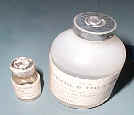 PPR Vaccine - TN/97 |
Strain Field isolate of PPR virus adapted and attenuated in Vero cells by serial passage for 75 times |
| Product Presentation |
Vaccine : Freeze dried as 50 doses vials Diluent : 50 ml in a polypropylene bottle |
| Product Utility |
The vaccine is useful to protect sheep and goats against PPR |
| For further details contact |
Dept. of Animal Biotechnology Madras Veterinary College Chennai - 600 007 |
| Scientists involved |
Dr. K.S. Venkataraman Dr. R. Manickam |
Product Technology 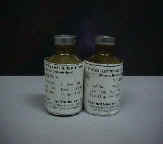 |
Development of a trivalent Leptospira (inactivated) vaccine for bovines incorporating the three Leptospiral serovars viz. Pomona, hardjoand grippotyphosa. The vaccine is Thiomersal inactivated, aluminum hydroxide gel absorbed vaccine to confer specific immunity against Leptospirosis in cattle |
| Product Presentation |
30 ml (5 doses)6 ml (Single Dose) |
| Product Utility |
The vaccine prevents leptospiral abortion, infertility, still birth and loss of milk production.It helps in the prevention of transmission of the disease from cattle to other livestock and human beings |
| For further details contact |
The Associate Professor and Head Leptospirosis Research Laboratory Centre for Animal Health Studies TANUVAS Madhavaram Milk Colony Chennai-600 051 |
| Scientists involved |
Dr. K. Rathnakumar Thiru S.A.Shanmugam Dr. P. Velayutham |
| Product Technology |
The design and the fabrication of insulated bag was based on the performance of insulation material, ice keeping capacity and suggestion of fishermen. Ice retention capacity of the bag after 10 hours was 62%. During the study it was found that initial temperature of +2oC increased to 10oC after adding equal volume of shrimps (10 kg). This again came down to +2 oC after one hour. At the end of 12 hours, temperature of iced shrimp was 8oC. This 12 hours period is sufficient for catamaran fishermen to complete their fishing trips. From the field study conducted covering 60 fishing days, it was found that zero percent spoilage was observed when the shrimp caught were transported in insulated bag with Ice, whereas in the uniced condition, spoilage was found to be 7-8% of the total catch |
| Product Presentation |
Fabricated bag has an innermost layer of aluminium sheet and one inch thickness of thermocole was placed in between the stitched laminated tarpauline. This Box is placed in a tarpauline bag having nylon handle on two sides. The inner dimesion of the bag is 30x30x30 cm (BxHxT) and the outer dimesion in 32.5x32.5x32.5 (BxHxT) |
| Product Utility |
As the holding capacity of the bag in 24 kg, it will conveniently hold 10 kg of fresh shrimp and 10 kg of Ice. This bag protect the shrimp against contamination, losses due to spoilage and also make it easier and safer to transport immediately after catch |
| For further details contact |
The Dean Department of Fish Processing Technology Fisheries College and Research Institute Thoothukudi - 628 008 |
| Scientists involved |
Dr. Berty Edwin Dr. M. Murugan |
| Product Technology |
The physical and chemical evaluations of the blocks were done as per standard procedures available in literature |
| Product Presentation |
Block of size 30x30x10 cm weighing approximately 1 kg |
| Product Utility |
The enriched paddy straw when compacted into high-density blocks along with essential nutrients will be an economic feed for low yielding milch animals. Further the straw can be made readily available with minimal transportation cost |
| For further details contact |
The Professor and Head Institute of Animal Nutrition Kattupakkam Chennai - 603 203 |
| Scientists involved |
Dr. A. Thangavelu Dr. K.S. Palaniswami Dr. V. Purushothaman |
Product Technology 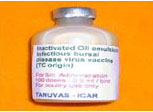
Incativated IBD Vaccine |
Cell grown IBDV, inactivated with BEI and oil adjuvanted with Montanide |
| Product Presentation |
Oil emulsion vaccine in multidose plastic bottle |
| Product Utility |
The vaccine is used for prophylaxis against IBD. Unprimed birds are vaccinated at 1 week of age. The Vaccine affords protection upto 10 weeks of age. This vaccine can be used as booster for the birds previously primed with live vaccine, at any time after 14 days |
| For further details contact |
The Professor and Head Department of Microbiology Madras Veterinary College Chennai - 600 007 |
| Scientists involved |
Dr.K.S.Palaniswami Dr.A.Thangavelu Mr.R.Velmurugan |
| Product Technology |
Live PPR virus serially passaged and simultaneously selected in higher temperature in vero cells |
| Product Presentation |
Vaccine : Freeze dried in a glass vial (50 doses) Diluent : 50 ml in a polypropylene bottle |
Product Utility 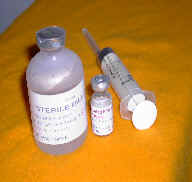 |
PPR is an acute, highly contagious and fatal rinderpest like disease of small ruminants and in unprotected animals the mortality may reach 60-70%. PPR virus first reported in India in 1987 from an outbreak in Tamil Nadu and since then the disease was reported from all over the country. The use of rinderpest vaccine to protect small ruminants against PPR is contraindicated because its use induces antibodies to rinderpest, which compromises sero-surveillance for rinderpest. Hence the present vaccine was developed for control of PPR in sheep and goats which is stable at room temperature and doesn't require cold chain. Stability at 37oC temperature for 21 days confirmed.It is used for prophylatic vaccination against PPR in sheep and goats |
| For further details contact |
Department of Microbiology Madras Veterinary College Chennai - 600 007 |
| Scientists involved |
Dr. K.V.S. Naryana Raju Dr. V.V. Kulkarni Dr. N. Punniamurthy |
| Product Technology |
This Ointment is prepared by adding Neats Foot Oil, extracted from the feet (last two phalanges) of cattle, buffalo, sheep and goats by a process of wet rendering at a pressure level of 15 PSI for 4 hours and purified with normal saline and acetone and filtered at a level of 20% in paraffin base. The consistency of the ointment should be homogenous and smooth |
| Product Presentation |
Neats foot oil ointment is semi solid product and can be stored in amber coloured glass / plastic containers for better shelf life |
| Product Utility |
The raw material is abundantly available at a comparatively low cost. The keeping quality of the oil is good. The ointment prepared will also be cheap and effective in healing the wounds |
| For further details contact |
The Professor and Head Department of Meat Science and Technology Veterinary College and Research Institute Namakkal - 637 001 |
| Scientists involved |
Dr.V.V. Kulkarni Dr. K. Sivakumar Dr. Robinson J.J. Abraham |
Product Technology 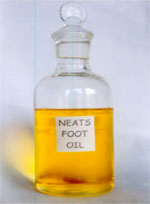 |
Neats Foot Oil is extracted from the feet (last two phalanges) of cattle, buffalo, sheep and goats by a process of wet rendering at a pressure level of 15 PSI for 4 hours. Crude oil is purified with normal saline and acetone and filtered |
| Product Presentation |
Neats foot oil is liquid at room temperature and can be stored in amber coloured glass / plastic containers for better shelf life |
| Product Utility |
Neats foot oil has a wide range of applications such as in ointment preparation in wound healing, lubricant in delicate machinery, fat liquoring agent in finishing of leather and oil adjuvants in injectable pharmaceutical preparations. The purified and fractioned neats foot oil has a very low solidification point below -10oC, and hence it can be used in specific machinery |
| For further details contact |
The Professor and Head Department of Meat Science and Technology Veterinary College and Research Institute Namakkal - 637 001 |